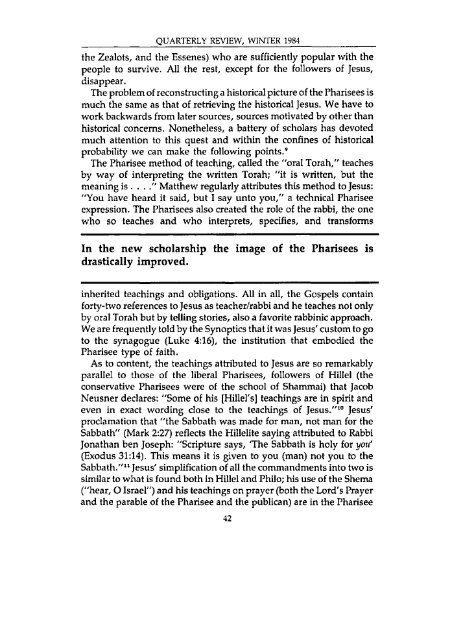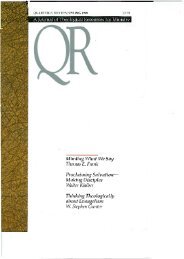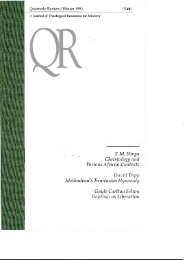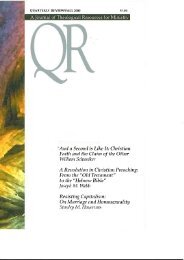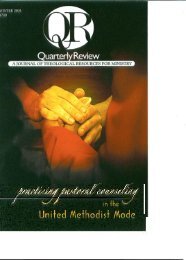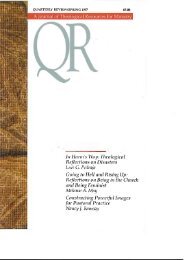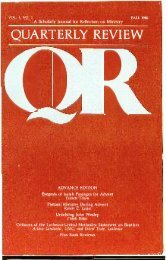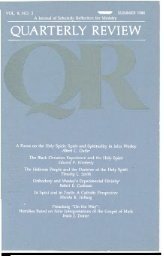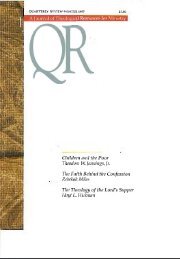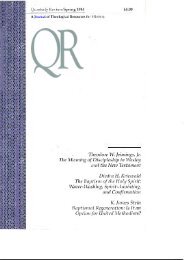Winter 1984 - 1985 - Quarterly Review
Winter 1984 - 1985 - Quarterly Review
Winter 1984 - 1985 - Quarterly Review
Create successful ePaper yourself
Turn your PDF publications into a flip-book with our unique Google optimized e-Paper software.
QUARTERLY REVIEW, WINTER <strong>1984</strong><br />
the Zealots, and the Essenes) who are sufficiently popular with the<br />
people to survive. All the rest, except for the followers of Jesus,<br />
disappear.<br />
The problem of reconstructing a historical picture of the Pharisees is<br />
much the same as that of retrieving the historical Jesus. We have to<br />
work backwards from later sources, sources motivated by other than<br />
historical concerns. Nonetheless, a battery of scholars has devoted<br />
much attention to this quest and within the confines of historical<br />
probability we can make the following points. 9<br />
The Pharisee method of teaching, called the "oral Torah," teaches<br />
by way of interpreting the written Torah; "it is written, but the<br />
meaning is . . . ." Matthew regularly attributes this method to Jesus:<br />
"You have heard it said, but I say unto you," a technical Pharisee<br />
expression. The Pharisees also created the role of the rabbi, the one<br />
who so teaches and who interprets, specifies, and transforms<br />
In the new scholarship the image of the Pharisees is<br />
drastically improved.<br />
inherited teachings and obligations. All in all, the Gospels contain<br />
forty-two references to Jesus as teacher/rabbi and he teaches not only<br />
by oral Torah but by telling stories, also a favorite rabbinic approach.<br />
We are frequently told by the Synoptics that it was Jesus' custom to go<br />
to the synagogue (Luke 4:16), the institution that embodied the<br />
Pharisee type of faith.<br />
As to content, the teachings attributed to Jesus are so remarkably<br />
parallel to those of the liberal Pharisees, followers of Hillel (the<br />
conservative Pharisees were of the school of Shammai) that Jacob<br />
Neusner declares: "Some of his [Hillel's] teachings are in spirit and<br />
even in exact wording close to the teachings of Jesus." 10<br />
Jesus'<br />
proclamation that "the Sabbath was made for man, not man for the<br />
Sabbath" (Mark 2:27) reflects the Hillelite saying attributed to Rabbi<br />
Jonathan ben Joseph: "Scripture says, 'The Sabbath is holy for you'<br />
(Exodus 31:14). This means it is given to you (man) not you to the<br />
Sabbath." 11<br />
Jesus' simplification of all the commandments into two is<br />
similar to what is found both in Hillel and Philo; his use of the Shema<br />
("hear, O Israel") and his teachings on prayer (both the Lord's Prayer<br />
and the parable of the Pharisee and the publican) are in the Pharisee<br />
42


